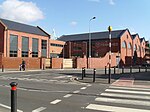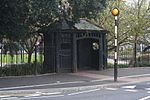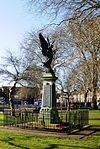
In the United Kingdom, a listed building is a structure of particular architectural and/or historic interest deserving of special protection. Such buildings are placed on one of the four statutory lists maintained by Historic England in England, Historic Environment Scotland in Scotland, Cadw in Wales, and the Northern Ireland Environment Agency in Northern Ireland. These have classifications that differ between: England and Wales, Scotland and Northern Ireland. The term has also been used in the Republic of Ireland, where buildings are protected under the Planning and Development Act 2000, although the statutory term in Ireland is "protected structure".

Cardiff Bay is an area and freshwater lake in Cardiff, Wales. The site of a former tidal bay and estuary, it is the river mouth of the River Taff and Ely. The body of water was converted into a 500-acre (2.0 km2) lake as part of a UK Government redevelopment project, involving the damming of the rivers by the Cardiff Bay Barrage in 1999. The barrage impounds the rivers from the Severn Estuary, providing flood defence and the creation of a permanent non-tidal high water lake with limited access to the sea, serving as a core feature of the redevelopment of the area in the 1990s.

Cathays is a district and community in the centre of Cardiff, capital of Wales. It is an old suburb of Cardiff established in 1875. It is densely populated and contains many Victorian terraced houses. The area falls into the Cathays ward. It is the third most populous community in Cardiff, having a population of 18,002 in 2011.

Grangetown is a district and community in the south of Cardiff, capital of Wales. It is one of the largest districts in the south of the city and is bordered by Riverside, Canton and Butetown. The River Taff winds its way through the area. Adjacent to the city's Cardiff Bay area, Grangetown is experiencing a period of gentrification and improvements in its infrastructure. Its population as of 2011 was 19,385 in 8,261 households. One of the "five towns of Cardiff", the others are Butetown, Crockherbtown, Newtown and Temperance Town.

Sophia Gardens is a public park in Riverside, Cardiff, Wales, on the west bank of the River Taff. International test cricket matches and county cricket matches are held in the Sophia Gardens cricket ground, the home of Glamorgan County Cricket Club. The gardens are listed on the Cadw/ICOMOS Register of Parks and Gardens of Special Historic Interest in Wales.

The Cardiff Blitz ; refers to the bombing of Cardiff, Wales during World War II. Between 1940 and the final raid on the city in March 1944 approximately 2,100 bombs fell, killing 355 people.

Public libraries in Cardiff are owned and operated by Cardiff Council. There are 20 public libraries in the capital of Wales, the largest of which is Cardiff Central Library. A mobile library service is also provided. In 2018/19, there were almost 91,000 Cardiff residents, around 25% of the city's population, who borrowed an item from a municipal library. Increases in visits, active borrowers and library members have taken place during 18/19 as the service continues to grow in popularity with Cardiff's citizens.

Cardiff Corporation Tramways was a company that operated an electric tramway service in Cardiff between 1902 and 1950.

St Paul's Church is a Grade II listed Church in Wales parish church opened in 1890 in Grangetown, Cardiff, Wales. Renovation work commenced in 2023 after a period of closure. Community consultation alongside further fundraising and renovation will continue after this period.

There are around 1,000 listed buildings in Cardiff, the capital city of Wales. A listed building is one considered to be of special architectural, historical or cultural significance, which is protected from being demolished, extended or altered, unless special permission is granted by the relevant planning authorities. The Welsh Government makes decisions on individual cases, taking advice from the heritage agency Cadw, the Royal Commission on the Ancient and Historical Monuments of Wales and local councils.
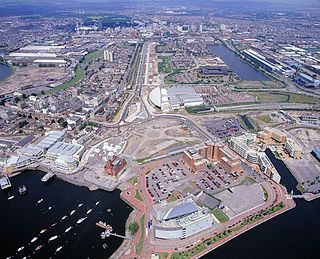
There are many listed buildings in Cardiff Bay, part of Cardiff, capital city of Wales. A listed building is one considered to be of special architectural, historical or cultural significance, and has restrictions on amendments or demolition. Buildings are listed as either Grade I, II* and II buildings lists, with the Grade I being the most important.

In the United Kingdom, the term listed building refers to a building or other structure officially designated as being of special architectural, historical, or cultural significance; Grade I structures are those considered to be "buildings of exceptional interest". Listing was begun by a provision in the Town and Country Planning Act 1947. Once listed, strict limitations are imposed on the modifications allowed to a building's structure or fittings. In Wales, the authority for listing under the Planning Act 1990 rests with Cadw.

In the United Kingdom, the term listed building refers to a building or other structure officially designated as being of special architectural, historical, or cultural significance; Grade I structures are those considered to be "buildings of exceptional interest". Listing was begun by a provision in the Town and Country Planning Act 1947. Once listed, strict limitations are imposed on the modifications allowed to a building's structure or fittings. In Wales, the authority for listing under the Planning Act 1990 rests with Cadw.
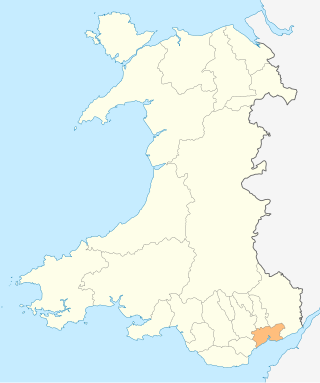
In the United Kingdom, the term listed building refers to a building or other structure officially designated as being of special architectural, historical, or cultural significance; Grade I structures are those considered to be "buildings of exceptional interest". Listing was begun by a provision in the Town and Country Planning Act 1947. Once listed, strict limitations are imposed on the modifications allowed to a building's structure or fittings. In Wales, the authority for listing under the Planning Act 1990 rests with Cadw.

In the United Kingdom, the term listed building refers to a building or other structure officially designated as being of special architectural, historical, or cultural significance; Grade II* structures are those considered to be "particularly important buildings of more than special interest". Listing was begun by a provision in the Town and Country Planning Act 1947. Once listed, strict limitations are imposed on the modifications allowed to a building's structure or fittings. In Wales, the authority for listing under the Planning Act 1990 rests with Cadw.

Tramshed is a music and arts venue in Cardiff, Wales, located in a Grade II-listed building that was once the old tram depot for west Cardiff. The newly redeveloped venue opened to the public in October 2015. It has a 1,000 capacity, however this is only reached up to six occasions per annum.

Mount Stuart Square is a residential and commercial square in Cardiff, Wales. It is located in the Butetown area of the city. Originally developed in the late 1800s as a residential location for nearby dock workers, it quickly became a centre for upscale residential properties which revolved around the main square. By 1900, commercial activity had taken its place, dominated by the Coal Exchange, which occupied the once open central space. The square contains a high concentration of listed buildings, which represent a range of architectural styles and some of Cardiff's finest examples of late 19th and early 20th century commercial architecture. Mount Stuart Square area was designated a Conservation Area in July 1980.

Hayes Island Snack Bar is located on The Hayes in the centre of Cardiff, Wales. It was built as a parcel depot for Cardiff Corporation Tramways in 1911. Closed in 1942, the kiosk was redeveloped as a snack bar which opened in 1948. It is described as the oldest operating snack bar in Wales. Since 2013 it has been operated by the Worton family, under licence from Cardiff Council. The kiosk is a Grade II listed building. The adjacent Ladies' and Gentlemen's toilets date from 1898 and were the first public conveniences in Cardiff. The toilets, and the two contemporary lamposts, are also Grade II listed.
